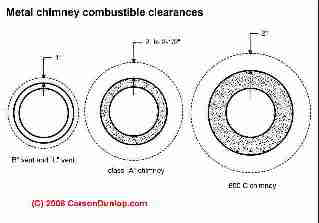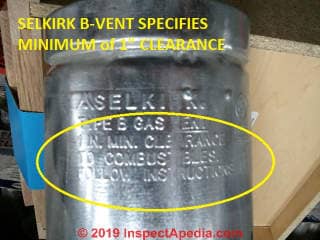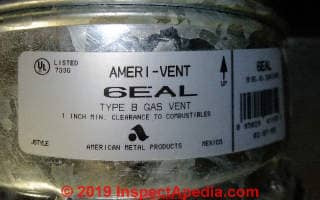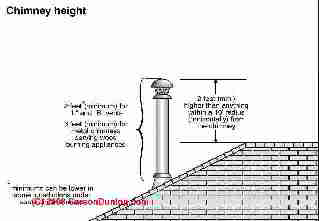 Fire Safety Clearance Requirements between Metal Chimneys & Combustible Materials
Fire Safety Clearance Requirements between Metal Chimneys & Combustible Materials
- POST a QUESTION or COMMENT about fire clearances for metal chimneys
Metal chimney fire clearance codes & specifications: this article describes the basic fire clearance requirements for four types of manufactured metal chimneys: B-vents, L-vents, Class A chimneys, and 650C Chimneys.
InspectAPedia tolerates no conflicts of interest. We have no relationship with advertisers, products, or services discussed at this website.
Fire Safety Clearance Required from Combustibles for Metal Chimneys
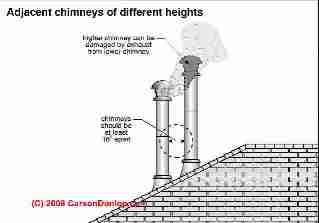 This article series on chimneys, chimney construction, and chimney safety provide detailed suggestions describing how to perform a thorough visual inspection of chimneys for safety and other defects.
This article series on chimneys, chimney construction, and chimney safety provide detailed suggestions describing how to perform a thorough visual inspection of chimneys for safety and other defects.
Adjacent Metal Chimney Separation Requirements
In addition to the requirement for safety fire clearance from rooftops and other building components, separate metal chimneys that are too close to one another may cause damage resulting in poor chimney performance or an unsafe chimney.
Carson Dunlop Associates [at REVIEWERS] sketch at left shows that metal chimneys should be at least 16 inches apart to avoid damage.
See CLASS A CHIMNEYS, MetalBestos™
Class A, B-Vent, & 650C Metal Chimney Fire Clearance Requirements
Carson Dunlop's sketch summarizes combustible clearance requirements for the three main types of metal chimneys:
- B-Vents - 1" clearance
- Class "A" Chimneys - 2" to 2 1/2" clearance
- 650 C Chimneys - 2" clearance
also see SUPER CHIMNEYS, 629 CHIMNEYS
Sketch courtesy Carson Dunlop.
Table of Clearances for Listed Flue Vent Connectors for Gas-Fired Heating Appliances
| Clearances for Listed Flue Vent Connectors for Gas-Fired Heating Appliances Minimum Distance from Combustible Materials |
||||
|---|---|---|---|---|
| Equipment | B-Vents | L-Vents | Single-Wall Metal Pipe | Factory-Built Chimneys |
B-Vents: Listed equipment w/ draft hood & equipment listed for use with B-Vents |
as listed | as listed | 6-inches | as listed |
Residential gas boilers/furnaces, gas conversion burner, draft hood |
6-inches | 6-inches | 9-inches | as listed |
L-Vents: Residential appliances listed for use with L-Vents |
not permitted | as listed | 9-inches | as listed |
Incinerators - residential |
not permitted | 9-inches | 18-inches | as listed |
Listed gas fired toilets |
not permitted | as listed | as listed | as listed |
Unlisted residential appliances with draft hood |
not permitted | 6-inches | 9-inches | as listed |
Residential & low-heat equipment other than items above |
not permitted | 9-inches | 18-inches | as listed |
Medium heat equipment |
not permitted | not permitted | 36-inches | as listed |
Notes to the metal chimney fire clearance table above
Watch out: "as listed" where shown in the table above means that the acceptable fire clearance distances for those chimney types must match or comply with the manufacturer's instructions; those clearance spacings are normally found in at least two locations:
- The installation instructions for the specific flue vent connector or metal chimney brand and model or product
- A stamping or label found right on the metal chimney product itself
We include an example here: the embossed stamping on a Selkirk B-vent for gas appliances that specifies a minimum of 1-inch clearance to combustibles.
Also see the chimney codes listed below.
Key Articles on Chimney, Flue, & Vent Clearances for Fire Safety & Building Code Compliance
- See CHIMNEY HEIGHT & CLEARANCE CODE for rooftop clearances required for most chimneys
- IMPORTANT: see CHIMNEY HEIGHTS for Types L & Type B Vents for the rooftop clearance requirements for manufactured chimneys such as Type L vents and Type B Vents
- IMPORTANT: see FIRE CLEARANCES, SINGLE WALL METAL FLUES & VENTS for the clearance from combustibles required for flue vent connectors (these are not chimneys, but rather the "flue pipe", "smoke pipe", or "stack pipe" that connects a heating appliance to a chimney.
- FIRE STOPPING in BUILDINGS - where fire blocking or fire stopping is required to slow the spread of fire or smoke in buildings
- THREE-SIDED CHIMNEYS for a special hazard in site-built chimneys
- Massachusetts Chimneys and Vents Code 780 CMR 68.00 (2007) [PDF]
- METAL CHIMNEYS & FLUES - topic home, for definitions and characteristics of the different types of metal chimneys.
- METAL CHIMNEY FLUE SEPARATION CODES - clearances for multiple metal chimney flues passing through a common chimney chase or inside a single masonry chimney
- CHIMNEY CLEANOUT CLEARANCE to COMBUSTIBLES for an article about the necessary clearance between a chimney cleanout opening and combustible materials
Reader Question: what's the code on distance and clearance for MetalBestos chimneys & vents vs oil storage tanks?
I am installing a pellet boiler and will need a second metal chimney as I am leaving my oil burner as a backup. I live in Maine. The only place I would like the metal asbestos chimney would run 40” away from my oil tank. Do you know what the code is on this? I am having a heck of a time getting any answers regarding this? - R. B. Windham ME 2/27/2014
Reply:
Insulated metal chimneys typically require a one-inch clearance from combustibles.
I think the reason you're not finding an answer to your question is that we're mixing up different constraints and safety concerns:
- The required separation or clearance distances for flue vent connectors (generally single-wall uninsulated metal "flue pipes" or "stack pipes" that connect the heater to the chimney) - discussed
at FLUE VENT CONNECTORS, HEATING EQUIPMENT - The required separation of metal or insulated chimneys themselves from various building components or combustibles - discussed
at FIRE CLEARANCES, METAL CHIMNEYS
and for height above roofs
at CHIMNEY HEIGHT & CLEARANCE CODE - The required separation of heating appliances (like an oil burner) from heating oil storage (the oil tank) - discussed
at ABOVE GROUND OIL STORAGE TANK (AST) INSPECTION
Reader Comments, Questions & Answers About The Article Above
Below you will find questions and answers previously posted on this page at its page bottom reader comment box.
Reader Q&A - also see RECOMMENDED ARTICLES & FAQs
On 2019-10-07 by (mod) - What is the original specification for clearances from the outer wall to combustibles for our fireplace and its chimney?
R Conn
Thanks for a really important metal chimney fire clearance safety question.
In the article above on this page we give typical fire clearance distances for the most-common types of metal flues and chimneys.
Watch out: Beyond that I'm way too chicken to bet your life and money and fire risk on a guessed answer. Instead, let's take a look at the specific metal chimney product you have installed; there will be embossed stampings or data tags on the metal flue product that give its brand and model and clearance minimums.
I don't know what Majestic fireplace model you have installed nor what fuel it's burning nor a thing about the surrounding construction; so the required clearance distances could vary.
For example, the MAJESTIC IO Manual for the Ashland Wood Burning Fireplace, 36" model [PDF] Majestic Products A Brand of Hearth & Home Technologies Inc.
Corporate Office
7571 215th Street West
Lakeville, MN 55044
Customer Service:1 (877) 486-9123 retrieved 2019/10/07 original source: https://downloads.hearthnhome.com/installManuals/Ashland%2036_ASH36_Installation%20Manual_4059-909.pdf warns
Comply with all minimum clearances to combustibles as specified. Failure to comply may
cause house fire.
and continues to give clearance distances at 40 spots in the manual .The sketch below is excerpted from that manual.
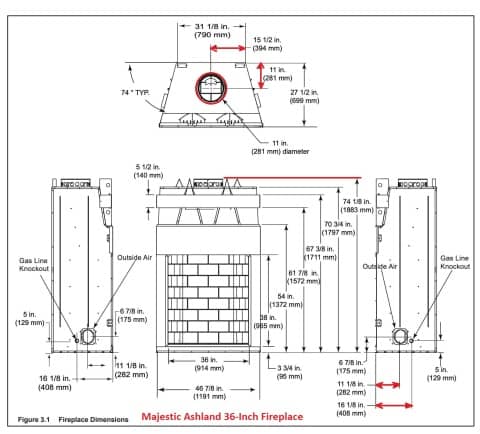
Below is a similar example showing the data tag on an Ameri-Vent Type B Gas Vent from American Metal Products, manufactured in Mexico and UL Listed.
On 2019-10-06 by R Conn - clearance distances for our Majestic Fireplace
I have a majestic fireplace installed in our home, I believe it was put in during the early to mid 70’s. It has a 3 wall metal chimney, it is not insulated, but air cooled between the 2’nd and 3’rd structures.
I believe the inside is stainless. The outside is galvanized. It is straight up a chimney chase inside the home. There is an insulated attic above the fireplace where the chimney penetrates then up through the roof with another roof mounted chase.
It appears to be in excellent condition. I’m having the home re-insulated, with high density cellulose.
It appears the original installation allows about 1.5” if clearance in a framed pass through the ceiling, in other words the current fiberglass insulation is about 1.5” away, leaving the lower chimney chase able to breath or release heat.
However it also allows cold air into that chamber during the winter, and we can feel the chase is very cold. It is not insulated very well, think fiberglass batts that have gaps.
What is the original specification for clearances from the outer wall to combustibles. is it 1” or 2”. I assume no contact is recommended. Thank you, Rick, Michigan
On 2017-11-23 by (mod) -
Pat,
Indeed this is a common complaint that we hear from readers: smoke and odors from a neighbour's chimney.
There are in most communities building regulations about distances from property lines or from nearby buildings that may help sort out what the neighbour is required to do.
In addition we give distances to adjacent buildings, windows, etc. in the "Other Key Articles" listed above on this page.
On 2017-11-23 by Pat
Our next door neighbor has about a 3 foot high metal chimney that vents their oil burner (they moved it to the garage). It's on their lower (garage) roof, and way below the height of their upper roof ridge line from the main part pf the house.
It's also right next to our bedroom windows. We're concerned about fumes, not to mention it's very noisy.
On 2017-04-13 by (mod) -
Anon:
Fire stops or fire blocking where?
The final legal approval of your fireplace installation is of course your local building official.
On 2017-04-13 by Anonymous
on a house with no occupied area above fireplace unit and only a vaulted are fire stops required for wood burner with pipe rated and supplied with unit 20' approx
Question:
(Feb 6, 2013) bill.fletchis@gmail.com said:
Can insulation be put next to the metal chimney in the attic area for a gas furnace
Reply:
Bill, some metal chimneys require an air space while others are rated for zero clearance. What kind of flue is this?
If it's a B-vent, typically you need to leave a 1" clearance around the vent - take a look at the "listed" clearance for your particular product - you'll see that advice in the table above.
Let me know what you find or email me the B-vent product name, specs, or any details you can and we'll research it together.
...
Continue reading at FIRE CLEARANCES INDOORS or select a topic from the closely-related articles below, or see the complete ARTICLE INDEX.
Or see these
Fire Stopping & Fire Clearance Articles
- TYPE B-VENT ROOFTOP CLEARANCE
- CHIMNEY CHASE CONSTRUCTION
- CHIMNEY CLEANOUT CLEARANCE to COMBUSTIBLES
- CHIMNEY CLEARANCE & CONDITION SAFETY
- CHIMNEY CREOSOTE FIRE HAZARDS
- CHIMNEY FIRE ACTION / PREVENTION
- CHIMNEY FLUE SEPARATION
- CHIMNEY CODES & STANDARDS
- CHIMNEY HEIGHT & CLEARANCE CODE
- CHIMNEY SHROUDS
- CONCEALED SPACE FIRE CODES
- FIRE-BLOCK Fire Retardant Foam Spray Building Insulation
- FIRE CLEARANCES INDOORS
- FIRE CLEARANCES, MASONRY CHIMNEYS
- FIRE CLEARANCES, METAL CHIMNEYS
- FIRE CLEARANCES, SINGLE WALL METAL FLUES & VENTS
- FIRE CLEARANCES WOOD & COAL STOVES
- FIRE RATINGS for ROOF SURFACES
- FIRE RETARDANT PLYWOOD
- FIRE & SMOKE DAMPERS, AUTOMATIC
- FIRE STOPPING in BUILDINGS
- FIRE STOPPING at CHIMNEY PASSAGES
- FLUE VENT CONNECTORS, HEATING EQUIPMENT
- METAL CHIMNEYS & FLUES - home
- METAL CHIMNEY INSTALLATION MANUALS
- METAL CHIMNEY FLUE SEPARATION CODES
- PYROLYSIS EXPLAINED
- UNLINED FLUE INSPECTIONS
- WILDFIRE DAMAGE PREVENTION for HOMES
- WOOD STOVE OPERATION & SAFETY
Suggested citation for this web page
FIRE CLEARANCES, METAL CHIMNEYS at InspectApedia.com - online encyclopedia of building & environmental inspection, testing, diagnosis, repair, & problem prevention advice.
Or see this
INDEX to RELATED ARTICLES: ARTICLE INDEX to CHIMNEYS & FLUES
Or use the SEARCH BOX found below to Ask a Question or Search InspectApedia
Ask a Question or Search InspectApedia
Try the search box just below, or if you prefer, post a question or comment in the Comments box below and we will respond promptly.
Search the InspectApedia website
Note: appearance of your Comment below may be delayed: if your comment contains an image, photograph, web link, or text that looks to the software as if it might be a web link, your posting will appear after it has been approved by a moderator. Apologies for the delay.
Only one image can be added per comment but you can post as many comments, and therefore images, as you like.
You will not receive a notification when a response to your question has been posted.
Please bookmark this page to make it easy for you to check back for our response.
Our Comment Box is provided by Countable Web Productions countable.ca
Citations & References
In addition to any citations in the article above, a full list is available on request.
- Mark Cramer Inspection Services Mark Cramer, Tampa Florida, Mr. Cramer is a past president of ASHI, the American Society of Home Inspectors and is a Florida home inspector and home inspection educator. Mr. Cramer serves on the ASHI Home Inspection Standards. Contact Mark Cramer at: 727-595-4211 mark@BestTampaInspector.com
- John Cranor [Website: /www.house-whisperer.com ] is an ASHI member and a home inspector (The House Whisperer) is located in Glen Allen, VA 23060. He is also a contributor to InspectApedia.com in several technical areas such as plumbing and appliances (dryer vents). Contact Mr. Cranor at 804-873-8534 or by Email: johncranor@verizon.net
- Thanks to Luke Barnes for suggesting that we add text regarding the hazards of shared chimney flues. USMA - Sept. 2008.
- Thanks to Bryce Olson, New London, CT, for technical editing and correction of clearance distances - 03/2009
- Thanks to reader Vic for technical editing and again, correction of clearance distances - 04/2009
- NFPA 211 - Standards for Chimneys & Fireplaces, NFPA 211: Standard for Chimneys, Fireplaces, Vents, and Solid Fuel-Burning Appliances, 2006 Edition (older editions and standards are found at the same bookstore)
- NFPA #211-3.1 1988 - Specific to chimneys, fireplaces, vents and solid fuel burning appliances.
- NFPA # 54-7.1 1992 - Specific to venting of equipment with fan-assisted combustion systems.
- GAMA - Gas Appliance Manufacturers' Association has prepared venting tables for Category I draft hood equipped central furnaces as well as fan-assisted combustion system central furnaces.
- National Fuel Gas Code, an American National Standard, 4th ed. 1988 (newer edition is available) Secretariats, American Gas Association (AGA), 1515 Wilson Blvd., Arlington VA22209, and National Fire Protection Association (NFPA), Batterymarch Park, Quincy MA 02269. ANSI Z223.1-1988 - NFPA 54-1988. WARNING: be sure to check clearances and other safety guidelines in the latest edition of these standards.
- Fire Inspector Guidebook, A Correlation of Fire Safety Requirements Contained in the 1987 BOCA National Codes, (newer edition available), Building Officials and Code Administrators International, Inc. (BOCA), Country Club HIlls, IL 60478 312-799-2300 4th ed. Note: this document is reissued every four years. Be sure to obtain the latest edition.
- Uniform Mechanical Code - UMC 1991, Sec 913 (a.) Masonry Chimneys, refers to Chapters 23, 29, and 37 of the Building Code.
- New York 1984 Uniform Fire Prevention and Building Code, Article 10, Heating, Ventilating, and Air Conditioning Requirements
- New York 1979 Uniform Fire Prevention & Building Code, The "requirement" for 8" of solid masonry OR for use of a flue liner was listed in the One and Two Family Dwelling Code for New York, in 1979, in Chapter 9, Chimneys and Fireplaces, New York 1979 Building and Fire Prevention Code:
- "Top Ten Chimney (and related) Problems Encountered by One Chimney Sweep," Hudson Valley ASHI education seminar, 3 January 2000, contributed by Bob Hansen, ASHI
- Chimney Inspection Checklist, Carson Dunlop, Associates, Toronto, Ontario
- "Rooftop View Turns to Darkness," Martine Costello, Josh Kovner, New Haven Register, 12 May 1992 p. 11: Catherine Murphy was sunning on a building roof when a chimney collapsed; she fell into and was trapped inside the chimney until rescued by emergency workers.
- "Chimneys and Vents," Mark J. Reinmiller, P.E., ASHI Technical Journal, Vol. 1 No. 2 July 1991 p. 34-38.
- "Chimney Inspection Procedures & Codes," Donald V. Cohen was to be published in the first volume of the 1994 ASHI Technical Journal by D. Friedman, then editor/publisher of that publication. The production of the ASHI Technical Journal and future editions was cancelled by ASHI President Patrick Porzio. Some of the content of Mr. Cohen's original submission has been included in this more complete chimney inspection article: CHIMNEY INSPECTION DIAGNOSIS REPAIR . Copies of earlier editions of the ASHI Technical Journal are available from ASHI, the American Society of Home Inspectors.
- Natural Gas Weekly Update: http://tonto.eia.doe.gov/oog/info/ngw/ngupdate.asp Official Energy Statistics from the U.S. Government
- US Energy Administration: Electrical Energy Costs http://www.eia.doe.gov/fuelelectric.html
- Our recommended books about building & mechanical systems design, inspection, problem diagnosis, and repair, and about indoor environment and IAQ testing, diagnosis, and cleanup are at the InspectAPedia Bookstore. Also see our Book Reviews - InspectAPedia.
- Ceramic Roofware, Hans Van Lemmen, Shire Library, 2008, ISBN-13: 978-0747805694 - Brick chimneys, chimney-pots and roof and ridge tiles have been a feature of the roofs of a wide range of buildings since the late Middle Ages. In the first instance this ceramic roofware was functional - to make the roof weatherproof and to provide an outlet for smoke - but it could also be very decorative.
The practical and ornamental aspects of ceramic roofware can still be seen throughout Britain, particularly on buildings of the Victorian and Edwardian periods. Not only do these often have ornate chimneys and roof tiles but they may also feature ornamental sculptures or highly decorative gable ends. This book charts the history of ceramic roofware from the Middle Ages to the present day, highlighting both practical and decorative applications, and giving information about manufacturers and on the styles and techniques of production and decoration.
Hans van Lemmen is an established author on the history of tiles and has lectured on the subject in Britain and elsewhere. He is founder member and presently publications editor of the British Tiles and Architectural Ceramics Society. - Chimney Inspection Checklist, Carson Dunlop, Associates, Toronto, Ontario
- Chimney & Stack Inspection Guidelines, American Society of Civil Engineers, 2003 - These guidelines address the inspection of chimneys and stacks. Each guideline assists owners in determining what level of inspection is appropriate to a particular chimney and provides common criteria so that all parties involved have a clear understanding of the scope of the inspection and the end product required. Each chimney or stack is a unique structure, subject to both aggressive operating and natural environments, and degradation over time. Such degradation may be managed via a prudent inspection program followed by maintenance work on any equipment or structure determined to be in need of attention. Sample inspection report specifications, sample field inspection data forms, and an example of a developed plan of a concrete chimney are included in the guidelines. This book provides a valuable guidance tool for chimney and stack inspections and also offers a set of references for these particular inspections.
- Fireplaces, a Practical Design Guide, Jane Gitlin
- Fireplaces, Friend or Foe, Robert D. Mayo
- NFPA 211 - Standards for Chimneys & Fireplaces, NFPA 211: Standard for Chimneys, Fireplaces, Vents, and Solid Fuel-Burning Appliances, 2006 Edition (older editions and standards are found at the same bookstore)
- Principles of Home Inspection: Chimneys & Wood Heating, in (Principles of Home Inspection), Carson Dunlop, Associates, Toronto, Ontario
- NFPA 211 - 3-1.10 - Relining guide for chimneys
- NFPA 211 - 3-2 - Construction of Masonry Chimneys
- NFPA 211 - 3-3 - Termination Height for chimneys
- NFPA 211 - 3-4 - Clearance from Combustible Material
- NFPA 54 - 7-1 - Venting of Equipment into chimneys
- Brick Institute of America - Flashing Chimneys
Brick Institute of America - Proper Chimney Crowns
Brick Institute of America - Moisture Resistance of Brick - American Gas Association - New Vent Sizing Tables
- Chimney Safety Institute of America - Chimney Fires: Causes, Effects, Evaluation
- National Chimney Sweep Guild - Yellow Pages of Suppliers
- In addition to citations & references found in this article, see the research citations given at the end of the related articles found at our suggested
CONTINUE READING or RECOMMENDED ARTICLES.
- Carson, Dunlop & Associates Ltd., 120 Carlton Street Suite 407, Toronto ON M5A 4K2. Tel: (416) 964-9415 1-800-268-7070 Email: info@carsondunlop.com. Alan Carson is a past president of ASHI, the American Society of Home Inspectors.
Thanks to Alan Carson and Bob Dunlop, for permission for InspectAPedia to use text excerpts from The HOME REFERENCE BOOK - the Encyclopedia of Homes and to use illustrations from The ILLUSTRATED HOME .
Carson Dunlop Associates provides extensive home inspection education and report writing material. In gratitude we provide links to tsome Carson Dunlop Associates products and services.


